The Columbian Shark, scientifically known as Ariopsis seemanni, can be a challenging species to care for. Despite its name, it’s not a true shark, but rather a type of catfish native to the fresh and brackish waters of Central and South America.
Recognised for their streamlined bodies, forked tail fins, and metallic silver colour, they make a unique addition to the aquarist’s tank. However, their care needs are complex, requiring specific water parameters and a sizeable aquarium due to their potential growth up to 14 inches.
Table of Contents
Columbian Shark Facts & Overview
| Columbian Shark Fact | Details |
| Scientific Name: | Ariopsis seemanni |
| Care Level: | Moderate to Advanced |
| Native Region: | Pacific coasts of Central and South America |
| Lifespan: | Up to 10-15 years in optimal conditions |
| Size: | Up to 35 centimetres |
| Family: | Ariidae |
| Diet: | Omnivore |
| Minimum Tank Size: | 300+ litres for a small group of fish (70 gallons) |
| Compatibility: | Compatible with a variety of similarly-sized species |
Appearance & Size
The Columbian Shark also known as Silver Tipped Sharks is a striking aquatic creature. They exhibit a elongated body which mimics the structure of true sharks, and a metallic silver hue that glistens under lights.
Distinctive features include a set of long barbels near their mouths, adding to their catfish lineage, and a prominent forked tail fin, reminiscent of their shark-like physique. In terms of size, the Columbian Shark grows impressively, potentially reaching lengths of up to 14 inches in a suitable environment.
The Columbian shark size should be taken into account when considering tank selection and mates, as they need ample space to swim freely and express their natural behaviours. So, while their appearance might lure you in, a full grown Columbian shark and care requirements call for thoughtful planning and proper aquarium management.
Lifespan & Distribution
The Columbian Shark, under ideal conditions, can live up to 15 years. Their longevity serves as a testament to their hardy nature and resilience. They are native to the coastal waters of Central and South America, from Mexico down to Peru, thriving in both fresh and brackish environments.
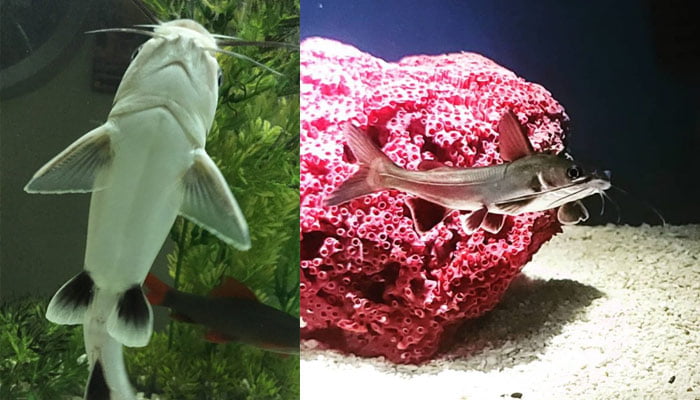
Behaviour & Temperament
Are Columbian Sharks Aggressive?
Despite their imposing appearance, Columbian Sharks are generally peaceful and sociable creatures. They cohabit well with other similarly sized and non-aggressive species. However, they may exhibit territorial behaviours and can become more assertive if kept in cramped conditions or with significantly smaller tank mates.
Therefore, providing ample space and an appropriate selection of tank companions is vital to maintain harmony within your aquarium.
Are Columbian Sharks Schooling Fish?
Columbian Sharks are considered a semi-schooling species. They exhibit strong social tendencies, particularly in their juvenile stage, favouring the company of their own kind in the aquarium. However, as they mature, they may tend to become more solitary but still appreciate the presence of other Columbian Sharks.
It’s recommended to keep them in small groups, replicating their natural social habits, to promote healthier and more natural behaviour. But bear in mind their large adult size – ensuring your tank is sufficiently spacious is paramount for their well-being.
Columbian Sharks’ Unique Communication
Columbian Sharks are not just great to look at but are also interesting due to their unique means of communication. They are known to create distinct sounds using their pectoral fins, a form of communication used especially during mating or when expressing distress.
This auditory display can often be heard by people, adding an extra layer of fascination to the care of these remarkable creatures. However, frequent distress noises can indicate less-than-ideal conditions in the tank, so it’s crucial to maintain an environment that meets their specific needs.
Aquarium Setup
Tank Size
Accommodating the large adult size of Columbian Sharks, the aquarium size is of prime importance. A tank of a minimum 300+ litres (75 gallons) ideally 400-500 litres is typically recommended for these species. It’s crucial to remember that Columbian Sharks are active swimmers and appreciate ample space to explore.
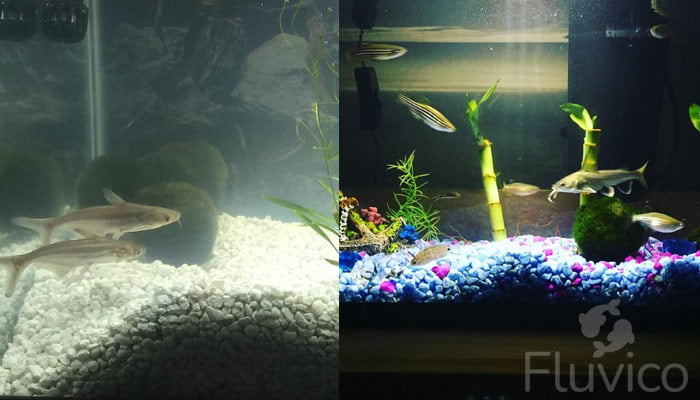
Filtration, Lights and Heating
- Filtration: Given their size and bio-load, Columbian Sharks necessitate a robust and efficient filtration system. The use of a canister filter or a sump system is highly recommended to ensure effective biological, mechanical, and chemical filtration.
- Lights: Columbian Sharks are crepuscular, meaning they are most active during dawn and dusk. Thus, they prefer moderate to low light conditions in the aquarium. Using dimmable lights or providing periods of subdued lighting can help mimic their natural environment.
- Heating: Maintaining an appropriate temperature is essential for the well-being of your Columbian Shark. A high-quality, reliable aquarium heater is needed to keep the tank temperature stable, ideally between 22-28°C, to mimic their natural tropical habitat.
Water Parameters
Columbian Sharks require specific water parameters to thrive. Maintaining these conditions is essential for their health and wellbeing:
- Temperature: A tropical species, Columbian Sharks prefer water temperatures between 22°C and 28°C. Consistency is key, sudden fluctuations can cause stress.
- pH: They prefer slightly acidic to slightly alkaline water, with a pH range of 6.0 to 8.0.
- Hardness: Moderate water hardness is ideal, though Columbian Sharks are generally adaptable to various hardness levels.
- Specific Gravity: As they can live in both freshwater and brackish environments, a specific gravity between 1.005 and 1.020 is recommended.
- Salinity: If you’re keeping them in a brackish setup, maintain a salinity level that aligns with the specific gravity mentioned above.
Remember, regular water testing is important to monitor these parameters and ensure a healthy environment for your fish.
Salinity, Specific Gravity and Substrate
Managing the salinity, specific gravity, and substrate appropriately are integral aspects of creating an ideal habitat for Columbian Sharks:
- Salinity: Columbian Sharks are brackish water fish, meaning they thrive in water that is more saline than freshwater but less than seawater. Ideally, aim for a salinity level between 1.005 and 1.010 ppt (parts per thousand).
- Specific Gravity: Corresponding with the salinity, the specific gravity should be maintained between 1.005 and 1.020. Regular monitoring is crucial to avoid abrupt changes that might stress your fish.
- Substrate: These fish possess delicate barbels that they use to probe their surroundings. Therefore, a soft, sandy substrate is most suitable as it mirrors their natural habitat and prevents any potential damage to their barbels. Steer clear of rough or sharp gravel that could injure your Columbian Shark.
The key to successful fishkeeping lies in consistent and careful maintenance of these parameters. Use reliable tools like hydrometers for specific gravity measurements, and invest in quality substrate to ensure a thriving environment for your Columbian Shark.
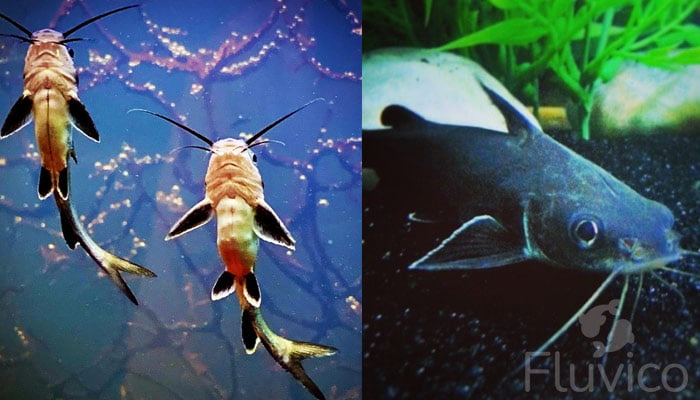
Plants and Decoration
Compatible Plants
Columbian Sharks require hardy plants that can withstand their active swimming habits. Here’s a selection of suitable species:
- Java Fern: A resilient plant that doesn’t require substrate, perfect for the active lifestyle of Columbian Sharks.
- Anubias: A sturdy species that securely anchors to rocks or driftwood, minimizing the risk of being uprooted.
- Amazon Sword: This plant’s strong root system can withstand the activity of larger fish like Columbian Sharks.
- Cryptocoryne: Known for their toughness, they can survive and even thrive in various conditions.
- Vallisneria: With their grass-like appearance, they create a natural-looking habitat and are resilient to active swimmers.
- Java Moss: This adaptable plant attaches to rocks, wood, and other surfaces, providing cover and reducing the risk of dislodgment.
Decorations
Creating an environment that mimics their natural habitat makes Columbian Sharks feel more at home:
- Large Rocks: Create structure and hiding spots, and add aesthetic appeal to the tank.
- Driftwood: Provides natural hideouts and can act as territorial markers, reducing disputes among tank inhabitants.
- Caves or Hollow Logs: Serve as additional hiding spots, contributing to the sense of security of your fish.
- Artificial Structures: If designed to mimic natural features, these can provide additional cover and territory markers.

Columbian Shark Care Essentials
Feeding and Dietary Requirements
Columbian Sharks have omnivorous dietary preferences. This means they eat a balanced mix of both meaty foods and plant matter, which makes catering to their nutritional needs relatively straightforward. Here’s a guide to what they should eat:
- Protein Source: Offer high-quality, sinking pellets or frozen foods such as brine shrimp, bloodworms, or daphnia. This provides the necessary protein they need for growth and health.
- Plant Matter: They also require a good amount of plant-based food in their diet. Algae wafers or blanched vegetables like spinach, peas, or zucchini can be included in their meals.
- Feeding Frequency: Typically, feeding them once or twice a day is adequate. The key is to offer only as much food as they can consume in a couple of minutes.
- Variety: A varied diet helps ensure your fish receive a wide range of nutrients, so try to provide different types of both meaty and plant-based foods.
Overfeeding can lead to health issues and pollute the tank water, so it’s important to feed your fish responsibly.
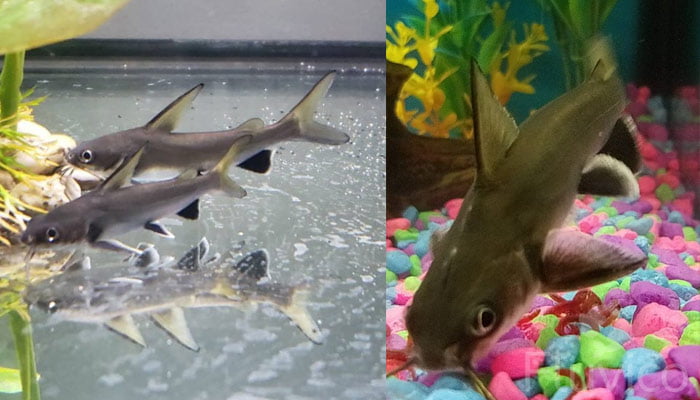
Maintenance and Disease Prevention
Maintenance:
- Water Quality: Regular water testing and partial water changes (about 25-30% weekly) are vital to maintaining optimal water conditions. This helps control waste build-up and keeps the water parameters stable.
- Filtration System: Clean and check your filtration system frequently to ensure it is functioning efficiently. Remember, Columbian Sharks produce a significant amount of waste, so a robust filtration system is necessary.
- Substrate and Decorations: Regularly clean the substrate and decorations to remove any accumulated waste or algae, but do this carefully to avoid disrupting the tank ecosystem.
Disease Prevention:
- Quarantine New Additions: Always quarantine new fish before introducing them to the main tank. This prevents the spread of potential diseases.
- Monitor Fish Health: Regularly observe your Columbian Sharks for any signs of illness such as changes in colour, appetite, or behaviour.
- Diet: A balanced diet is key to boosting your fish’s immune system, helping them fend off diseases.
- Stress Minimisation: Stress can make fish more susceptible to diseases. Avoid overcrowding, sudden changes in water parameters, and ensure proper tank setup to keep stress levels low.
Regular maintenance and a proactive approach to disease prevention can go a long way in ensuring the health and longevity of your Columbian Sharks.
Common Diseases
Columbian Sharks, like any other fish, can be susceptible to a variety of diseases. Awareness of these common diseases can help you respond promptly and possibly prevent their spread:
- Ich (White Spot Disease): Characterised by small, white, grain-like spots on the body. Often occurs due to stress, like abrupt changes in water temperature. Treatment usually involves raising the tank temperature slightly and adding a formulated ich medication.
- Fin Rot: This bacterial infection results in the fraying or discolouration of fins. It often occurs in poor water conditions or due to injury. Treatment involves improving water quality and possibly using a targeted antibiotic.
- Velvet (Gold Dust Disease): This parasite manifests as a fine, gold or rust-coloured film on the fish’s body. Fish may also exhibit rubbing or scratching behavior. Treatment involves medication specifically formulated to kill the parasite.
- Fungal Infections: Symptoms include fluffy, white growths on the skin, gills, or fins. Often occur due to injury, stress, or poor water conditions. Antifungal treatments are available.
- Swim Bladder Disease: Can result in the fish having difficulty swimming or floating on one side. Often caused by overfeeding or a diet lacking in fibre. Fasting the fish or feeding them a pea can help.
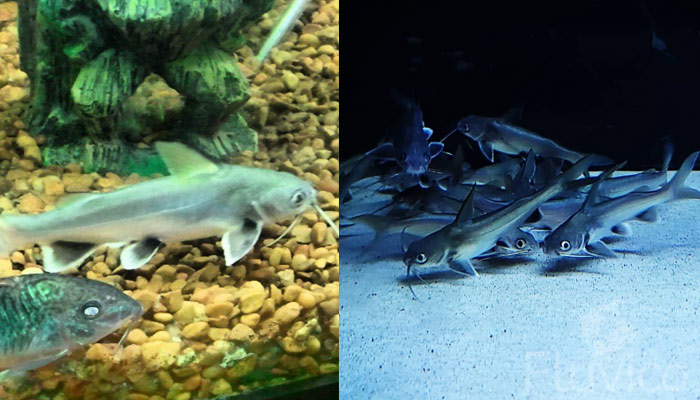
Columbian Shark Tank Mates
Compatible Tank Mates
Columbian Sharks are fairly peaceful and can be kept with a variety of other fish, provided they share similar water conditions and size. Here are some suitable companions:
- Other Columbian Sharks: They enjoy the company of their own kind and do well in small groups or pairs.
- Larger Characins: Species like Silver Dollars or larger Tetras can cohabit well due to their similar size and temperament.
- Brackish Water Species: Species such as Mollies, Gobies, and Monos thrive in the same brackish conditions.
- Catfish: Larger, peaceful catfish species are a good choice due to their similar size and non-aggressive nature.
- Archer Fish: They can tolerate similar brackish water conditions.
- Bala Sharks: Despite their name, Bala Sharks are actually peaceful schooling fish and can be compatible with Columbian Sharks, provided the tank is sufficiently large to accommodate both species’ size and activity level.
Incompatible Tank Mates
Certain species are not a good fit due to their size, temperament, or habitat requirements. These include:
- Very Small Species: Small fish such as Neon Tetras, Guppies, or Dwarf Rasboras might be seen as prey due to the significant size difference.
- Slow-Moving Species: Slow-moving or docile species like Discus or Angel Fish may become stressed due to the active and fast nature of Columbian Sharks.
- Overly Aggressive Species: Fish that are known for their aggressive behaviour, such as Cichlids or some species of Betta, can stress the relatively peaceful Columbian Sharks.
- Strict Freshwater Species: Fish that strictly require freshwater conditions, such as many Corydoras or Tetra species, won’t thrive in the brackish conditions needed by Columbian Sharks.
- Territorial Bottom Dwellers: Species like Rainbow Sharks or Red-Tailed Black Sharks may see Columbian Sharks as competitors for territory, leading to conflict.
Observing the behaviour of your tank inhabitants is key to maintaining a harmonious community. If conflicts occur, it may be necessary to rehouse some individuals.
Columbian Shark Breeding
Breeding Columbian Sharks in captivity is a challenging process due to their specific environmental needs and size. Columbian Sharks have a unique requirement for brackish water conditions, and maintaining this in a breeding setup can be challenging.
Breeding these fish should only be attempted by experienced aquarists with a strong understanding of their needs. However, if you’re dedicated and equipped with the right setup, it can be attempted. Here are the steps you would need to follow:
Duration: Typically 5-6 Months
Identify the Sexes:
Female Columbian Sharks tend to be larger and have a more rounded belly, while males are smaller and slimmer. However, sexing can be difficult, so you might need to consult an expert.
Establish a Breeding Tank:
Set up a separate, large breeding tank with brackish water. The tank should have a sandy substrate and plenty of hiding spots using rocks and driftwood. Maintain optimal water conditions—temperature around 24-26°C, pH around 7.0-8.0, and specific gravity around 1.005-1.010.
Introduce Breeding Pair:
Introduce a healthy, mature pair (one male and one female) to the breeding tank.
Diet:
Feed the breeding pair a nutritious, varied diet to encourage spawning. This should include high-quality pellets or flakes, live or frozen foods such as brine shrimp or bloodworms, and plant matter.
Spawning:
If conditions are right, the female will lay eggs which will be fertilised by the male. Unlike many fish species, Columbian Sharks are livebearers, meaning the female carries the eggs inside her body and gives birth to live young.
Rearing the Young:
Once the young are born, they should be removed to a separate tank to grow. They can be fed finely crushed flake food or specially prepared fry food.
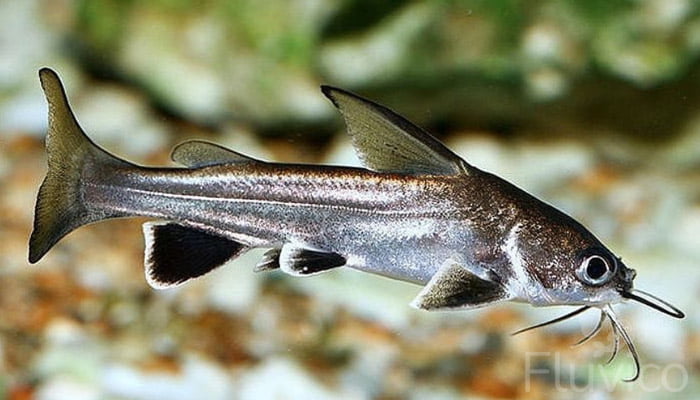
Should You Get a Columbian Shark for Your Aquarium?
When considering adding a Columbian Shark to your aquarium, it’s essential to weigh the benefits and drawbacks to make an informed decision:
Benefits:
- Fascinating Species: Columbian Sharks are intriguing due to their unique behaviours, stunning appearance, and distinct communication methods, adding an element of interest to your tank.
- Adaptable Diet: As omnivores, these fish aren’t picky eaters and will accept a broad range of foods, simplifying feeding.
- Peaceful Temperament: Columbian Sharks generally have a peaceful nature, which means they can get along with a variety of other fish species.
- Long Lifespan: With proper care, these sharks can live up to 15 years, offering a long-term companionship.
Drawbacks:
- Large Size: Columbian Sharks grow quite large (up to 35cm), requiring a spacious tank (ideally 200 litres or more) to accommodate their size and active nature.
- Brackish Water Conditions: These fish thrive in brackish water, which requires specific knowledge and maintenance to achieve the right balance of salinity.
- Compatibility: Due to their size, these sharks can’t be kept with very small or slow-moving fish species, limiting the choice of tank mates.
- Active Swimmers: Columbian Sharks are very active and will need plenty of room to swim, which might disrupt more docile tank mates.
In essence, Columbian Sharks can be a rewarding addition to your aquarium if you’re equipped to meet their specific needs. Their unique characteristics make them a joy to observe, but their larger size and brackish water requirements may present challenges, particularly for beginner aquarists.
Therefore, it’s crucial to consider these factors before deciding to welcome a Columbian Shark into your aquarium.
FAQ
Are Columbian Sharks Poisonous?
No, Columbian Sharks are not poisonous. They pose no harm to humans or other fish species in terms of venom or toxins, making them safe to handle with the usual caution applied to fish care.
Are Columbian Sharks aggressive?
Generally peaceful but can be semi-aggressive if their tank is too small or overcrowded. Proper tank setup and management can ensure they cohabitate peacefully with compatible tank mates.
How fast do Columbian Sharks grow?
Columbian Sharks grow relatively fast, reaching their full size of approximately 35 centimetres within 2-3 years, given optimal living conditions, adequate space, and a nutritious, varied diet. Their growth rate can vary depending on their specific environment.
Why is my Columbian Shark not eating?
May be due to stress, unsuitable water conditions, illness, or dietary monotony. Ensure your water parameters are optimal, your shark isn’t being bullied by tank mates, and you’re providing a varied diet to encourage eating.
What do you feed a Columbian Sharks?
Feed them a balanced diet of high-quality pellets or flakes, supplemented with live or frozen foods like brine shrimp or bloodworms, and occasional plant matter such as spirulina or blanched vegetables.
Do Columbian sharks need salt water?
Columbian Sharks are brackish water fish, requiring a mix of fresh and salt water in their tanks. They can tolerate a wide range of salinity, but it’s crucial to maintain consistent, optimal conditions for their health.
More Reading

15 Types of Cryptocoryne: Which is Best For Your Aquarium Setup?

16 Awesome Low Light Aquarium Plants (Mosses, Ferns & Stem Plants)


18 Types of Aquarium Moss: Photos, Care, Propagation & Growth Guide


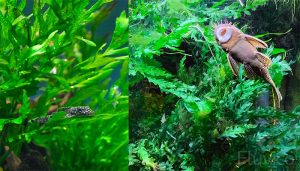


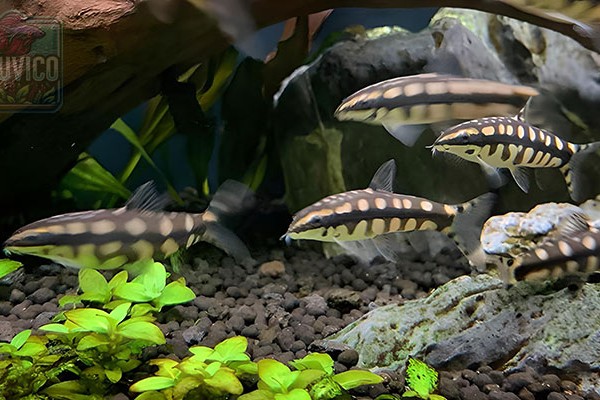
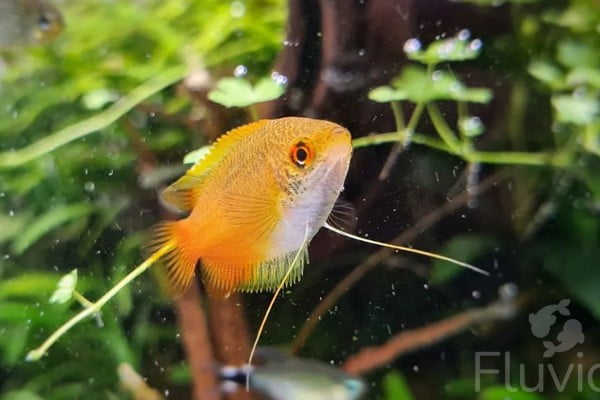
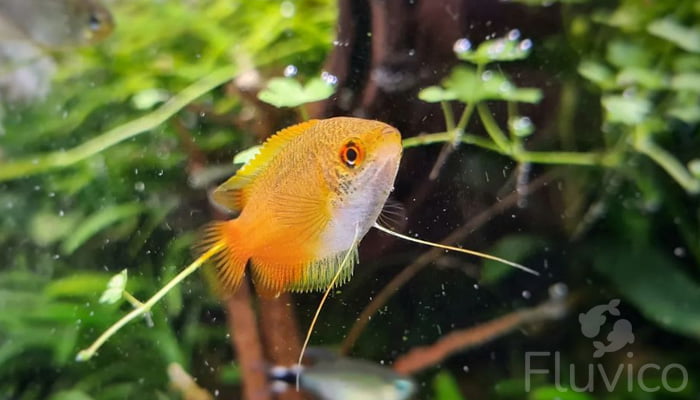
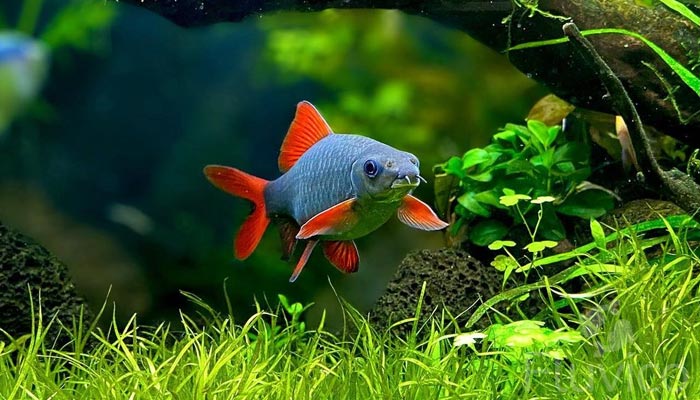

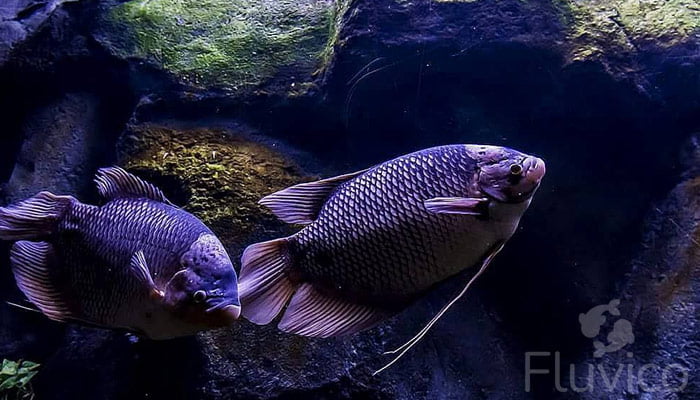
Hope you enjoyed our Columbian Shark Care Guide!
If you have any questions? Ask away, we’re here to help!
All the best,
Daniel